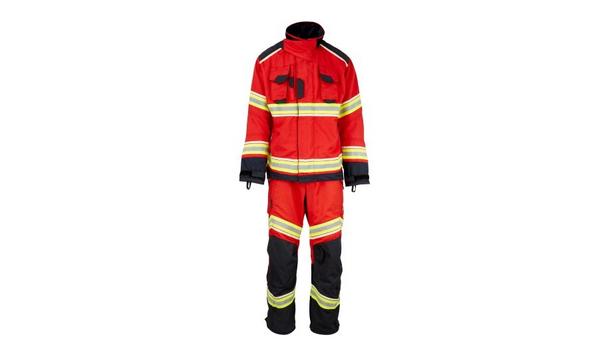FlamePro (UK) Limited - Experts & Thought Leaders
Latest FlamePro (UK) Limited news & announcements
Wildland fires are an increasing threat in the United Kingdom. They’re high risk, difficult to manage, and create a set of very particular circumstances for firefighters, who are battling the blaze. And with wildland call-outs measured in days, rather than hours, fire services need a kit that’s as tough as the terrain that they’re working on. Defender wildland firefighting suit FlamePro, a British manufacturing specialist of life-saving garments for firefighters, has unveiled a new wildland firefighting suit, challenging the industry by setting a new benchmark for PPE (Personal Protective Equipment). The ‘Defender’ wildland suit features military-grade FR plastic hardware. It passes a heat resistance of 260 °C, even after 40 wash and dry cycles, meeting the high demands of the latest wildland standard. Superior comfort and with glow-in-the-dark tape The suit encompasses strategic paneling, which is shaped to offer easy movement for wearers Comfort and ergonomics are at the forefront of the design. The suit encompasses strategic paneling, which is shaped to offer easy movement for wearers. The precise location of the paneling also improves the breathability of the suit. This provides the much-needed airflow, so as to reduce the risk of heat stress, which the extreme conditions of wildland firefighting pose. The Defender suit also features photo-luminescent, glow-in-the-dark tape for operational effectiveness. These strips aid the location of colleagues in near, or even total, darkness. They’re visible even when you can’t see your hand in front of your face. featuring shoulder reinforcement and 3D padding Lugging heavy equipment into remote areas of land is part and parcel of wildland firefighting. Therefore, the Defender suit is equipped with shoulder reinforcement and 3D padding over the main fabric, providing added comfort for firefighters wearing a bulky backpack. The suit also includes ergonomically shaped knee panels, with reinforced fabric, to protect firefighters against thorns, gorse, and other annoying hazards that lurk in the undergrowth. Enhanced Versatility Available in red or yellow, the new Defender suit will also fit any body type, available in an industry-renowned range of 96 sizes and fits. FlamePro’s Technical Sales Manager, Reece Buchner, said “By their nature, wildland fires create a set of very particular circumstances. The remote location, the intense heat and the long duration of these emergencies, all combine to create extreme and high-risk incidents. This means that firefighters need unique protection.” Reece Buchner adds, “The only PPE that will suffice is that, which has been designed specially to protect against every one of the risks that wildland firefighting poses. Our Defender suit does just this. We’re not interested in just meeting standards, we aim to be setting them. Our military-grade materials, teamed with ergonomic design, offer the ultimate combination of protection and comfort.”
Cancer is a hidden killer amongst the force. In fact, firefighters have a 68% higher risk of being diagnosed with cancer than the general population! Why? It’s simple, exposure to cancer-causing particles is high. But, this hidden killer can be stopped in its tracks, with careful PPE inspection and maintenance. Here, Reece Buchner, Technical Sales Manager at FlamePro, a British specialist manufacturer of life-saving garments for firefighters, explains how to maintain and inspect the kit. Specialist cleaning services While previous generations would have worn scorch marks and dirt as a badge of honor, firefighters know different. A fire suit is only as good as its weakest seam, and therefore kit needs to be checked A clean kit is a safe kit, so it’s essential that brigades utilize specialist cleaning services, ensuring that kits are correctly washed and cared for after every single use. Regular inspections of fire kits are just as important as laundering. A fire suit is only as good as its weakest seam, and therefore kit needs to be checked that it is fit for purpose before every use. Withstanding blunt pressure Here are five steps that will help preserve the life of the kit: Back to basics - It sounds simple, but check the surface of the fabric first and foremost. One should be looking for holes, rips, tears, and scuffs - even just the smallest rip or graze can impact on a kit’s protection. This should be conducted both prior to using the kit and after each shift. Now you see me - Whether called out to a rescue in dark and hazardous conditions, battling through thick plumes of smoke, or attending a road incident amidst live traffic, being easily seen is vital to ensuring safety on the job. A kit with good visibility enhances not only one’s own safety, but also that of the team. A torch test will check the reflective surfaces of a fire suit. Shine a torch over reflective surfaces to make sure they remain reflective. This also applies to non-fire kits, such as a rescue-wear set. Wet, wet, wet - Maintaining water repellence is crucial. Not only does it allow for more effective and comfortable working, it ensures that harmful chemicals and particulates are not able to infiltrate through the material. And it’s incredibly easy to check if a suit is still water tight - simply spray it with water. If the water pools in droplets on the surface, the durable water repellent (DWR) layer is working effectively. But if it soaks into the fabric, the DWR has failed and the garment needs re-treating. Safely sealed - Even the smallest amount of damage to a suit can compromise its ability to protect. And this includes fastenings, seals, zips, and poppers. These seals provide an important line of defense for firefighters – they ensure full body protection in extreme heat, and are designed to ensure corrosive liquids, carcinogenic particles, and other harmful substances can’t infiltrate the kit. Stress test - UV exposure can gradually wear fabric. This won’t be immediately visible, but tired fabric whilst on a job will soon become apparent. Make sure to stress test the fabric and ensure it can withstand blunt pressure. Do this by pushing a blunt object against the fabric. The object shouldn’t go through, but if it does, it’s a good indicator of UV damage. Check the Velcro - If one has been in a grassy environment, the Velcro can easily become matted and fail to close properly. This compromises protection against particulates. It is also paramount that zips and other fasteners are checked and ensured that they are closing properly. No matter how well one maintains the kit, there will always come a time when it will need replacing. So, it’s important to know when this time comes. Replacing the kit at the right time keeps the team safe and comfortable, no matter what the call-out is for.
Wildland fires are perceived as increasing risk in the UK, having been added to the National Risk Register of Civil Emergencies in 2012. High risk and difficult to manage, wildland fires create a set of very particular circumstances, meaning that firefighters need flexible kits that will help them do their job whilst tackling these incidents. Nathan Bricknell, general manager at FlamePro explains the advantages of a specialist wildland fire turnout kit and what other situations can it be used for. Different kits for wildland fires By their nature, wildland fires tend to occur in remote areas, meaning firefighters may have to walk a long way from appliances, often carrying hoses and other equipment. Not only this, while the heat from the fire isn’t as ferocious as being in a burning building, it can still be intense. And as wildland fires are often a risk during summer heatwaves, firefighters have to contend with not only heat generated by the fire, but also the ambient air temperature as well. Firefighters have to contend with not only heat generated by the fire, but also ambient air temperature as well Additionally, wildland fires can often see more than one fire raging during an incident, creating increased levels of radiant heat, as well as multiple locations in need of response. Of all the types of incidents, wildland fires are the ones that tend to go on the longest. With this combination of factors, it’s easy to understand why these types of incidents can increase the risk of on-scene firefighters suffering from heat stress. Type of PPE for wildland fires Wearing just a t-shirt on a firefighters’ top half leaves the arms exposed to heat and cancer-causing particulates. Meanwhile walking through wildland conditions in structural leggings will likely damage them, and the weight and heat protection a structural suit provides means firefighters wearing something unnecessarily heavy. Fire services should have a dedicated, lightweight turn-out kit for wildland fires to allow firefighters to cover the distances needed. This type of kit doesn’t necessarily need the heat protection that a standard turn-out kit requires, which provides scope to allow for a single-layer, more highly breathable garment. Wildland leggings need to have a closure at the bottom to stop sparks, smoke, and debris from going up the legs and exposing firefighters to carbon and particulates on the skin. Using stand out colors for PPE The kit ensures firefighters are swiftly identifiable, using colors such as red which will stand out against the landscape It’s also important that, when operating over large areas and sometimes from multiple brigades, the kit ensures firefighters are swiftly identifiable, using colors such as red which will stand out against the landscape. The most structural kit is now gold, which acts as a camouflage against the moorland landscape. Reflective elements are also helpful as efforts to fight wildland fires can often continue overnight. Finally, like all professional firefighting kits, garments designed for tackling wildland fires need to have a good range of pockets for storing radios and other essential equipment. Multi-functional PPE Garments designed for wildland fire response share many of the same qualities needed for rescue suits, meaning some wildland PPE ranges available on the market, including FlamePro, are intended to be multi-purpose. This multifunctional approach saves brigades from having to buy extra firefighting PPE.
The New Future For Fire Agencies
DownloadThe Eight Key Trends in Fire Detection in 2023
DownloadA Digital Platform to Improve Fire Safety Compliance and Inspections
DownloadOvercoming the Challenges of Fire Safety in the Paper Industry
DownloadCarbon Monoxide: Creeping Killer Caught In The Act
Download
















